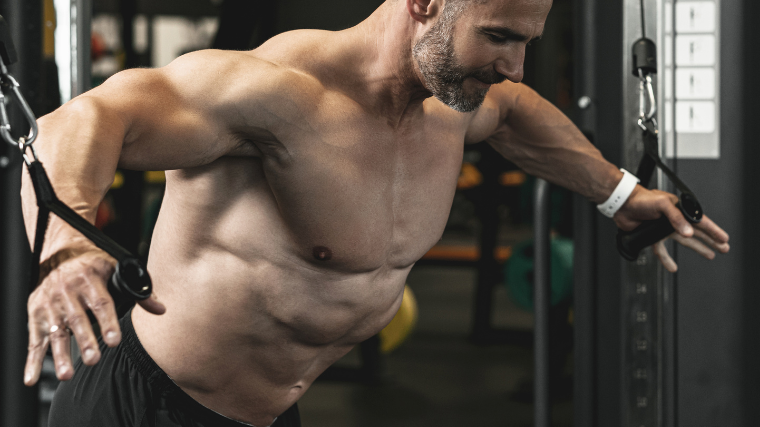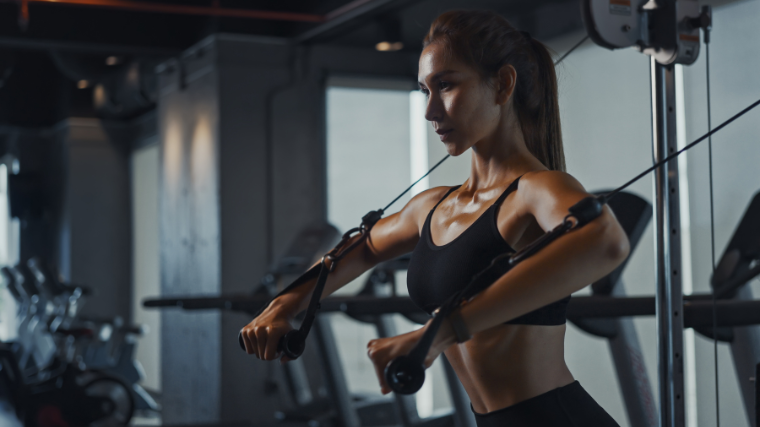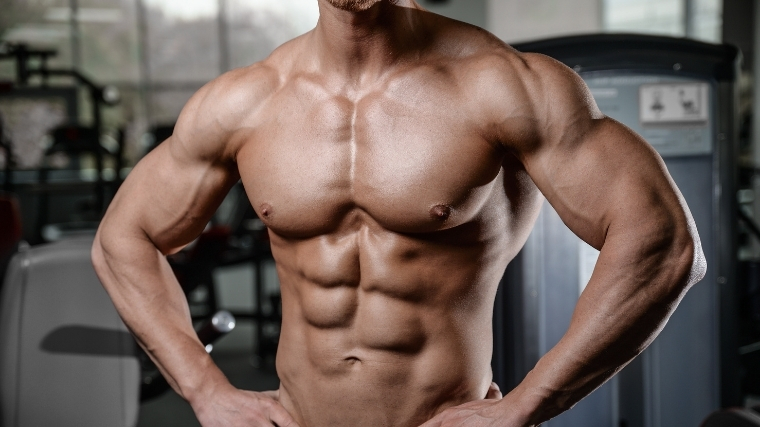From push-ups to bench pressing, there’s a high probability that you’ll see some serious pectoral fixation every Monday at the gym. Each lifter has their own routine for when international chest day comes around.
This can, unfortunately, mean lineups for many coveted machines or benches. However, if you shift your gaze, you can usually find a good old cable stack system ripe for the picking.
For shirt-splitting pumps and some new tricks for chest day gains, try these cable chest workouts!
Best Cable Chest Workouts
- Cable Chest Workout for Beginners
- Cable Chest Workout for Intermediates
- Cable Chest Workout for Advanced Lifters
Cable Chest Workout for Beginners
Cables are a great way to introduce a new challenge to your chest development. Dumbbells, barbells, and machines are excellent tools and should remain in your program, but cables are particularly useful for the pecs.
As a beginner, you can emulate many of the exercises you already perform with other implements to sort of “test the waters” with cables. Build up your skill and stability and you’ll experience a long runway of progress — and chest growth along with it!
The Workout
Select a handful of exercises that mimic your previous chest workouts in the gym. A good rule of thumb would be one type of press and one flye to make for a great initial chest workout.
Since cables are a new challenge, utilizing an adjustable bench with a backrest to help stabilize will be a great choice here as well. Nail three sets on each exercise and you should be pretty cooked in the chest department.
- Seated Cable Chest Press: 3 x 10-12
- Seated Cable Chest Fly: 3 x 12-15
Coach’s Tip: Try utilizing a 2-count controlled eccentric tempo (lowering portion) for each repetition to help maintain control and tension across your chest.
Cable Chest Workout for Intermediates
As you progress with your chest gains, you’ll likely need to ratchet up your volume, intensity, or even add more exercises to keep making gains. Your chest is a unique muscle group in that it that can allow for a bit more freedom and creativity; you have a lot of angles of attack that a cable system is uniquely capable of helping you hit. Selecting a few different angles to press and pull from will be a great focus here.
The Workout
Although you cannot necessarily target the inner or outer chest, you can set up your cable attachment such that certain pec fibers have more leverage than others; allowing them to bear more mechanical tension.
Building off of the beginner workout, utilize an incline bench to target the upper chest a bit more. You can also perform the pec fly standing and angle it at a slightly declined angle to hit the lower chest more specifically. Keep a flat press involved but keep progressing the intensity for a well-rounded chest workout.
- Seated Cable Chest Press: 2 x 8-10
- Seated Incline Cable Chest Press: 2 x 10-12
- Standing Cable High-to-Low Fly: 3 x 12-15
Cable Chest Workout for Advanced Lifters
Cables are inherently more difficult to stabilize than some other types of equipment, particularly free weights. Machines can be quite easy to train close to failure with because they “automate” the range of motion on your behalf.
As an advanced lifter, you should be able to take these cable exercises similarly close to failure without stability being an issue due to your experience with training.
With that in mind, removing the back support from your weight bench and allowing for a greater range of motion and more high-intensity sets will be your pathway to progress.
The Workout
Many chest exercises draw upon the pectoralis major, the anterior deltoids, and the triceps in combination. As you get more and more advanced, choosing exercises that carve out specific areas of your chest is one programming option available to you, but removing synergists is a strong second choice.
At this stage, relying more on heavy, high-intensity flye and crossover exercises can be a great tool to eliminate the triceps from the equation and place all the load directly onto the pecs.
While your anterior deltoids will still play a role, there won’t be as many supporting muscles to keep the chest itself from working as hard as possible in a more isolated fashion.
- Seated Cable Chest Press: 3 x 8-10
- Low-to-High Cable Chest Fly: 3 x 12-15
- High-to-Low Cable Chest Fly: 3 x 12-15
Coach’s Tip: Try to fully protract your arms and squeeze your chest on each repetition – likewise, try to fully retract your shoulder blades between each repetition for the best results.
How to Progress Cable Chest Workouts
At some point, you might experience a plateau in your chest gains, either in visual growth or through the numbers in your training log. Assuring progress during your cable chest workouts can be as straightforward as managing intensity, volume, or improving stability.
Intensity
Sometimes all it takes to kickstart new growth or get you to the next level is a bit more intensity. Intensity (meaning how hard you’re working, or how heavy the weights are relative to your 1-rep max) is a good predictor of progress.
You can get yourself into striking distance of muscular failure in a few easy ways. You can gradually tack on more weight, add in a slow tempo, or even utilize intensifiers such as drop sets. Finding a way to make the end of your set as hard as you can, safely, can be a super effective way to bust through stagnating workouts.
Volume
A more gradual way to ensure continued progress is by using volume. Although intensity should certainly still be present, adding progressively larger amounts of training volume is another option to keep moving forward with your chest gains.
Specifically, shooting for an increase in the number of repetitions performed during one or more of your sets of exercise is a great way to generate progress workout-over-workout.
Stability
Cables are a fantastic piece of equipment, but they do provide less external stability than exercise machines. With this in mind, your ability to brace and support your own body can make or break your set.
If you find that you’re starting to jiggle around or even miss the last few reps of a set because you can’t keep the cables (or your body) steady, you have a new opportunity to create progress.
[Read More: Best Upper Chest Exercises for Building Muscle]
You can work on your internal and external stability by adding slower tempo to your movement or, if you’re after a real chest challenge, start doing certain movements with a staggered stance or place one leg on an elevated surface.
Benefits of Cables for Chest Training
Cables are one of the best tools to employ when training a muscle group like the chest. They allow nearly every exercise to be trained regardless of body size, they can be used in both bilateral or unilateral fashion, and are extremely easy to progress.
They Suit All Body Sizes
There are many instances where a “good” movement isn’t good for you. The width of your shoulders or the length of your limbs can make it difficult for different lifters to utilize the same tools. Cables, on the other hand, enable you to tailor each exercise to your own specific structure, allowing for a wide variety of training opportunities.
Bilateral and Unilateral Opportunities
Cables are fantastic tools for training both bilateral or unilateral exercises. Bilateral training means using both sides of the body at the same time, whereas unilateral usually means training one side of your body at a time.
While cable chest workouts can be performed truly unilaterally (all repetitions completed on one side and then the other), they needn’t be to still provide benefits. You’ll still see solid gains to your stability and coordination, since each line of a cable tree moves freely from the other.
Easy to Progress
While the increments of most cable systems are locked in somewhere between five and seven-and-a-half pound jumps, you can easily progress your cable training via other avenues.
You can make gains by adding repetitions, slowing down your tempo, or reducing your rest periods to challenge other aspects of athleticism while getting one heck of a chest workout along the way. Plus, these broad athletic qualities will confer well to your other workouts if you’re diligent about targeting them.
Anatomy of the Chest
The chest is a large muscle group in itself, but it can also be subdivided into more specific regions to target as your experience level increases.
Pectoralis Major
The pectoralis major is the primary muscle that makes up the chest compartment. It is a large, fan-shaped muscle that originates all along the breastbone, down into a few of the ribs, and up into the collarbone.
Your pec major thens insert onto the upper part of your arm bone, meaning that the pectoralis major is hugely responsible for drawing the upper arm towards and across the body.
Due to the unique shape with multiple sites of origin, it can be beneficial to know where each area of the chest specifically originates to help understand how different arm paths during exercises can better predict your gains.
Upper Pec
The upper pectoralis major (or “upper chest”) originates from the front of the collarbone – specifically the middle half or so towards the middle of your body.
This means that more incline motions (either pressing or flyes) can help target the “upper chest” as the arm follows an upper angle more in line with these fibers. Think incline cable pressing or flyes here.
Middle Pec
The middle pectoralis major fibers originate primarily along the breastbone itself (the hard middle part of your chest). As the sternum is effectively a straight line running up and down, exercises that draw your arm across the body will help target the “middle chest” more specifically.
Standard-issue cable pressing or flyes are great at hitting the middle chest, particularly if you allow your hands to cross over each other to truly squeeze the pecs at their end-range of flexion.
Lower Pec
The lower pectoralis major fibers originate from the floating ribs primarily (the lower part of your ribcage). This means that any exercise that takes your arm from a high-to-low diagonal path should help target the “lower chest” a bit more. Decline cable flyes would be a good option.
Shirt-Stretching Time
Everyone loves the bench press, but it isn’t the only option at your disposal if you want to create a great chest day. Tossing in cable exercises can be a new way to bring some fun and intensity to your training.
Cable work is also much better suited for building up specific areas of your chest, or getting a great mind-muscle connection. Machines or free weights can be extremely beneficial, but sometimes you just need a good cable chest workout to really hit all the angles. Scope out your local cable stack machine on your next chest day and see for yourself.
Featured Image: BLACKDAY / Shutterstock



